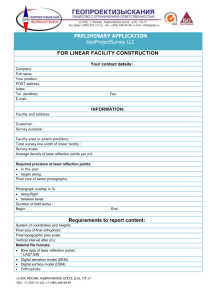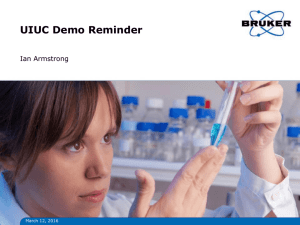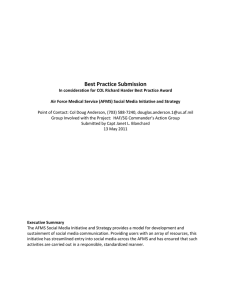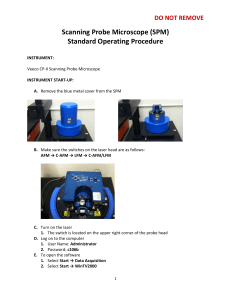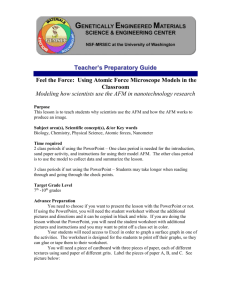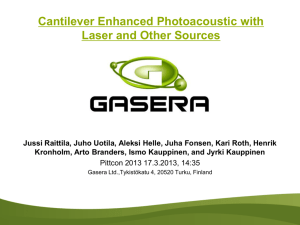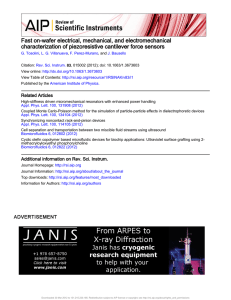STEM ED/CHM Nanotechnology at UMass Amherst
advertisement
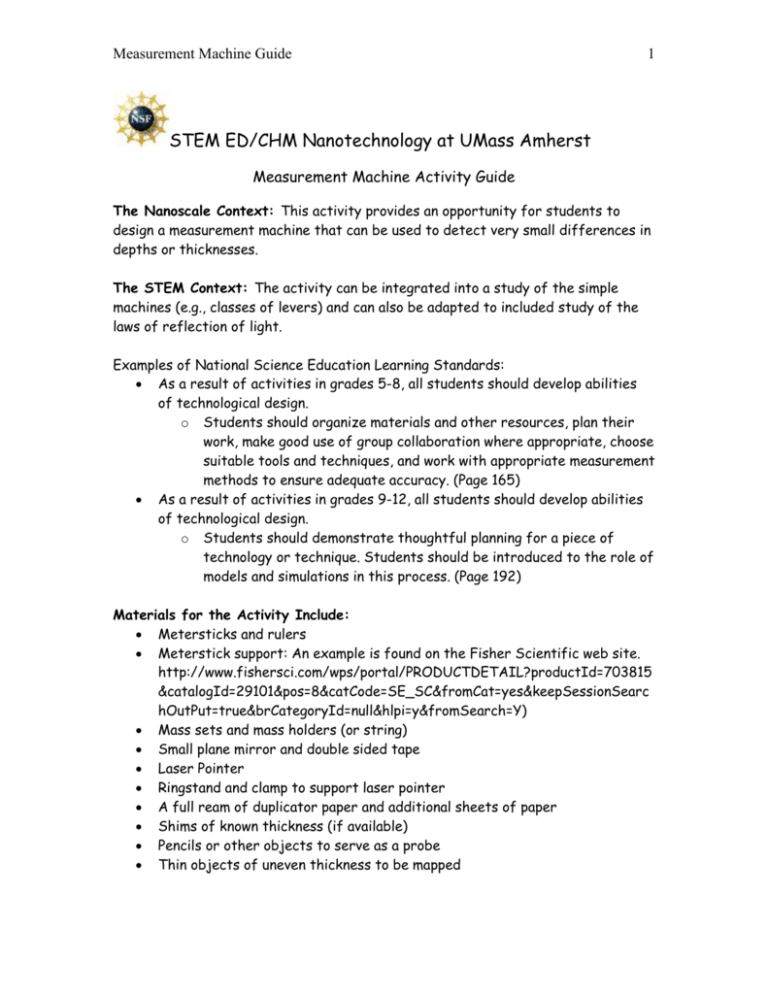
Measurement Machine Guide 1 STEM ED/CHM Nanotechnology at UMass Amherst Measurement Machine Activity Guide The Nanoscale Context: This activity provides an opportunity for students to design a measurement machine that can be used to detect very small differences in depths or thicknesses. The STEM Context: The activity can be integrated into a study of the simple machines (e.g., classes of levers) and can also be adapted to included study of the laws of reflection of light. Examples of National Science Education Learning Standards: As a result of activities in grades 5-8, all students should develop abilities of technological design. o Students should organize materials and other resources, plan their work, make good use of group collaboration where appropriate, choose suitable tools and techniques, and work with appropriate measurement methods to ensure adequate accuracy. (Page 165) As a result of activities in grades 9-12, all students should develop abilities of technological design. o Students should demonstrate thoughtful planning for a piece of technology or technique. Students should be introduced to the role of models and simulations in this process. (Page 192) Materials for the Activity Include: Metersticks and rulers Meterstick support: An example is found on the Fisher Scientific web site. http://www.fishersci.com/wps/portal/PRODUCTDETAIL?productId=703815 &catalogId=29101&pos=8&catCode=SE_SC&fromCat=yes&keepSessionSearc hOutPut=true&brCategoryId=null&hlpi=y&fromSearch=Y) Mass sets and mass holders (or string) Small plane mirror and double sided tape Laser Pointer Ringstand and clamp to support laser pointer A full ream of duplicator paper and additional sheets of paper Shims of known thickness (if available) Pencils or other objects to serve as a probe Thin objects of uneven thickness to be mapped Measurement Machine Guide 2 Introducing the Activity Show a Multi-Media Module The following URL is a link to the for the STEM Education Institute’s Nanotechnology Summer Institutes. The “Educational Materials, Modules, and Presentations” link will provide access to a multimedia module that describes the designs and applications of Atomic Force Microscopes. That module will provide students with a frame of reference for constructing a measurement machine. The AFM multimedia module does require a high speed Internet connection and computers with sufficient speed and memory. http://umassk12.net/nano/ AFM (and SPM) web sites. Atomic Force Microscopy is one category of Scanning Probe Microscopy. The following are a few examples of Internet web sites that can also be used to provide descriptions of the design of AFMs. http://stm2.nrl.navy.mil/how-afm/how-afm.html http://en.wikipedia.org/wiki/Atomic_force_microscope http://www.nanoscience.com/education/AFM.html http://www.mobot.org/jwcross/spm/ (This take a few minutes to download) http://www.nanoworld.org/english/english.html http://invsee.asu.edu/Modules/modsum/spmSUM.htm Demonstrate the Use of Materials to Build a Measurement Machine. There are some essential differences between the design of an AFM and the machine that the students will construct. AFMs typically have a probe at the end of a cantilever as shown in the diagram below. The use of a cantilever in constructing a model of an AFM would make it more difficult for students to manipulate the model and to mathematically analyze the data that they collect. Source: http://en.wikipedia.org/wiki/Atomic_force_microscope Measurement Machine Guide 3 Management of the Activity: Taking the time to construct a measurement machine before presenting the activity to students has many benefits. It can provide an understanding of the time requirements for the activity and an understanding of the space required for each group of students. By experimenting with adjusting the design of the model, a teacher can be in a better position to provide advice students when the difficulties arise and to encourage teams of students put themselves in the roles of engineers. The key management issues are associated with the use of a laser pointer and mirrors. One strategy can be to have each group of students complete Steps 1 through 8 of the procedure before providing laser pointers. Teachers can then determine if the arrangement of each groups model will allow for laser beams to reach wall areas (or a ruler supported in a vertical position) without intersecting unintended targets (especially people). Optional Extensions of the Model Activity Analyzing Torques This extension of the Measurement Machine activity provides an opportunity for students to analyze the torques created by the weight of the objects on the level mechanism. Each group’s model will result in different pairs of clockwise and counterclockwise torques. The emphasis of the analysis can be on the need to balance torques that result from the weight of the mirror and hanging mass in order to maximize the sensitivity of the measurement machine. AFMs are designed to minimize the downward pressure exerted by the probe on the object being mapped. There can also be a discussion of the difference between a first class lever and a cantilever. Analyze the Pathways of Light The extension of the Measurement Machine activity provides an opportunity for students to analyze the reflection of the beam of laser light from mirrors. Each group’s model will results in different pairs of angles of incidence and reflection as well as different distances that the incident and reflected beams of light travel. The emphasis of the analysis can be on determining if the angles of incidence and reflection are equal to each other at each mirror. The emphasis can also be on the influence of the distance that beams of light travel on motion multiplying effect of the model.




